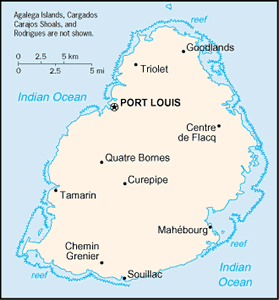The Geography of Mauritius
The Geography of Mauritius
Mauritian Geography
Location: Southern Africa, island in the Indian Ocean, east of Madagascar
Geographic coordinates: 20 17 S, 57 33 E
Map references: Political Map of the World
Area: total: 2,040 sq km land: 2,030 sq km water: 10 sq km note: includes Agalega Islands, Cargados Carajos Shoals (Saint Brandon), and Rodrigues
Area - comparative: almost 11 times the size of Washington, DC
Land boundaries: 0 km
Coastline: 177 km
Maritime claims: measured from claimed archipelagic straight baselines territorial sea: 12 nm exclusive economic zone: 200 nm continental shelf: 200 nm or to the edge of the continental margin
Climate: tropical, modified by southeast trade winds; warm, dry winter (May to November); hot, wet, humid summer (November to May)
Terrain: small coastal plain rising to discontinuous mountains encircling central plateau
Elevation extremes: lowest point: Indian Ocean 0 m highest point: Mont Piton 828 m
Natural resources: arable land, fish
Land use: arable land: 49.02% permanent crops: 2.94% other: 48.04% (2005)
Irrigated land: 220 sq km (2003)
Natural hazards: cyclones (November to April); almost completely surrounded by reefs that may pose maritime hazards
Environment - current issues: water pollution, degradation of coral reefs
Environment - international agreements: party to: Antarctic-Marine Living Resources, Biodiversity, Climate Change, Climate Change-Kyoto Protocol, Desertification, Endangered Species, Environmental Modification, Hazardous Wastes, Law of the Sea, Marine Life Conservation, Ozone Layer Protection, Ship Pollution, Wetlands signed, but not ratified: none of the selected agreements
Geography - note: the main island, from which the country derives its name, is of volcanic origin and is almost entirely surrounded by coral reefs; home of the dodo, a large flightless bird related to pigeons, driven to extinction by the end of the 17th century through a combination of hunting and the introduction of predatory species


